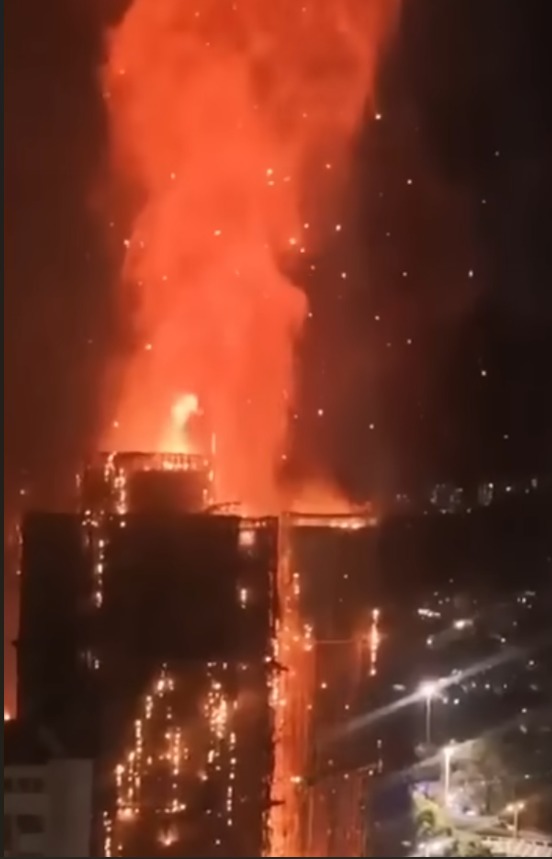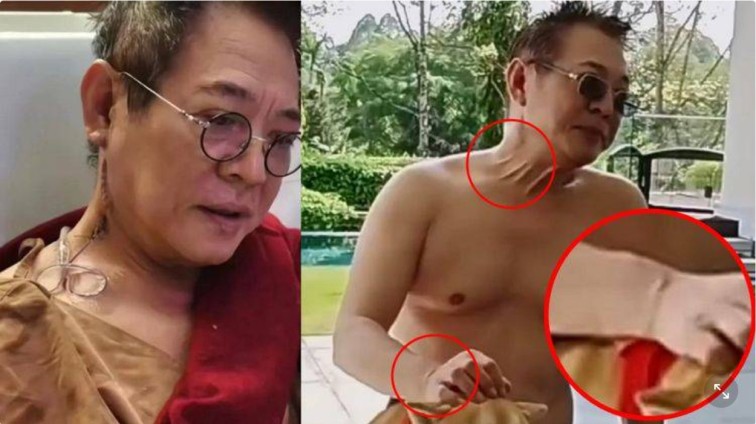Hong Kong fire on November 26th. (video screenshot)
[People News] Citing multiple media reports, a massive fire broke out on the afternoon of the 26th at “Wang Fuk Court,” a housing estate in Tai Po, New Territories, Hong Kong. The bamboo scaffolding erected for exterior wall repairs instantly became fuel, and under strong winds the flames rapidly spread to multiple buildings, creating a rare Grade 5 (the highest level) fire. It has already caused 65 deaths, and more than 200 people are reportedly missing. Early in the morning, police arrested two directors of a construction engineering company and one engineering consultant in Tai Po, Ngau Tau Kok, and San Po Kong, respectively. The three were arrested on suspicion of “manslaughter.”
This is the most deadly fire in Hong Kong in thirty years, and it once again draws attention to the longstanding high-risk practice of using flammable bamboo scaffolding and protective nets. Residents said that although fire alarms were installed inside the building, they did not sound when the fire broke out that afternoon.
Before the fire, the exterior walls of Wang Fuk Court were surrounded by bamboo scaffolding. In Hong Kong’s dense urban environment with extreme vertical heights, bamboo scaffolding can be seen everywhere; sometimes hundreds of feet tall and built around skyscrapers, wrapped in fabric safety nets that create bright green, blue, or purple cocoon-like structures. CNN noted that bamboo scaffolding is used not only for new construction, but also for renovations of thousands of high-rise buildings and historic tong lau (“tong lau”) every year.
Wang Fuk Court is 42 years old, with eight buildings and 1,984 residential units. Prior to the fire, the estate was undergoing exterior wall repairs, so all buildings were covered with bamboo scaffolding. Around 3 p.m. on the 26th, residents saw bamboo scaffolding on one building’s exterior wall catch fire; due to strong winds, flames quickly spread along the scaffolding to other buildings, causing a chain fire, and many units also ignited internally due to high heat and flames from the exterior walls.
On X, user Monsterblocckhk (@0xScottlai) raised questions:
The scene was Wang Fuk Court in Tai Po, which has eight residential towers. At around 2:51 p.m. on the 26th, bamboo scaffolding caught fire on the outer wall of Wang Cheung House while repairs were in progress. Some users on Threads captured small flames at the time, but within ten minutes the fire had already spread upward.
Issue 1: Some residents reported that the fire alarm did not sound when the fire broke out, and thick smoke suddenly rushed in, leaving many without enough time to escape. This indicates that the residential complex not only had external fire hazards but also had aging or nonexistent internal fire safety equipment.
Issue 2: Multiple netizens and residents posted photos and videos on Threads showing workers smoking and carelessly discarding cigarette butts on the scaffolding of one of the buildings under repair. While it cannot be confirmed that the images were taken on the day of the fire, some believe this was the cause, and residents had previously reminded workers many times not to smoke.
Issue 3: Background of the Repairs
In early 2024, the Wang Fuk Court owners’ corporation approved a large-scale renovation plan worth about HK$330 million for the overhaul of the entire exterior wall.
The plan covered eight buildings with roughly 1,984 units. Each household would pay in six installments, amounting to HK$160,000–180,000 per household. The issue is that this renovation was mandatory for all owners, and to reduce costs, repairs were conducted on all eight buildings simultaneously.
Owners protested, but the corporation refused to hold new elections and responded to some owners with legal action. The renovation proceeded, and the entire estate was covered with bamboo scaffolding and protective nets.
Here we must mention a Hong Kong system: Wang Fuk Court is a private housing estate, so it is not directly managed by the government. Instead, the incorporated owners’ committee hires contractors—private engineering companies. The Hong Kong Owners’ Corporation (OC) is essentially the “self-governing body of owners,” similar to “homeowners’ associations” in mainland China. It is a statutory legal entity composed of property owners and established under the Building Management Ordinance (Chapter 344). It manages the common areas of the building.
Private engineering projects do not have to follow government standards, so the bamboo scaffolding and regular flame-retardant nets they used—though legal—carry high risks. In recent years, the Hong Kong government has brought in large numbers of foreign workers but lacks regulations to supervise or control them. Workers have very low base salaries, and contractors are unwilling to provide safety training. Therefore, the author suspects that foreign laborers without safety knowledge caused the fire by smoking.
Thus, this was not an isolated accident but the result of contractors cutting costs by using cheap scaffolding and poorly supervising workers.
Major fires in Hong Kong over the past 30 years—such as on Gloucester Road in Causeway Bay, Jordan in Kowloon, Wah Fung Building on Argyle Street, Yau Ma Tei tong lau, and the Hung Hom fire—have generally involved similar causes.
The first issue is subcontracting in the renovation and construction market, which is most common. After winning a project, contractors subcontract to other companies or labor brokers, creating a multi-layer subcontracting chain. Each layer takes a cut, forming a “gray industry chain,” leading to delays, unsafe construction, blocked fire exits, illegal rewiring, “job grabbing,” “lowballing, and kickbacks.” Not only are contractor profits minimal, workers’ wages also cannot be guaranteed.
The second issue is the struggle for control between developers and owners’ corporations. Renovation and exterior wall repairs often involve maintenance funds worth tens of millions of Hong Kong dollars. Whoever controls the corporation controls massive project budgets. So, even though owners elect the corporation, corruption can grow if there is no oversight. In 2010–2024, multiple Hong Kong fires were linked to long-term infighting within owners’ corporations and favoritism toward specific contractors.
This renovation project involved huge profits, and the corporation proceeded without gaining majority owner approval. It also employed outdated bamboo scaffolding, clearly indicating shady dealings. Therefore, not only the contractors controlled by Hong Kong authorities should be held accountable—members of the Wang Fuk Court owners’ corporation should also bear responsibility.
△











News magazine bootstrap themes!
I like this themes, fast loading and look profesional
Thank you Carlos!
You're welcome!
Please support me with give positive rating!
Yes Sure!